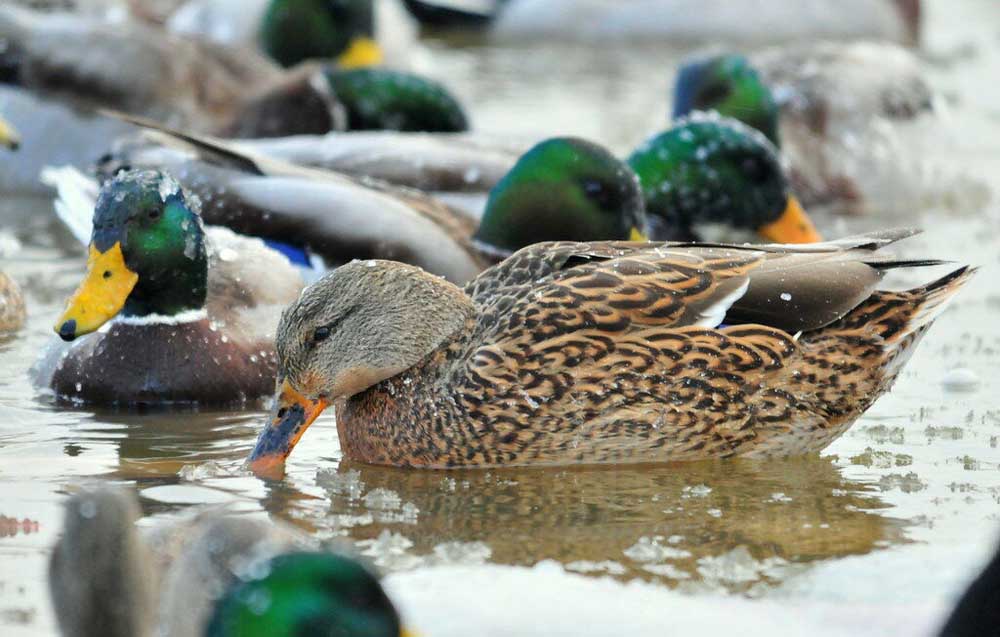Not Ducky: Hunting pressure, change in DNA impacting North American mallards
Published 9:00 am Friday, January 31, 2025

- Hunting pressure has impacting mallard activity in the Central Flyway, but a bigger concern may be coming from the east where releasing pen-reared birds is affecting the ducks’ DNA, migration habits and reproduction. (USFWS/Courtesy)
Another duck season has ended in the Central Flyway, and once again hunters in Texas were left asking where the birds are.
Despite a couple of late Arctic pushes the ducks, which for most avid hunters means mallards, seemed scarce in the state. Actually, hunters were saying the same thing in Oklahoma.
But is often the case with duck hunting perception does not always agree with reality.
Kevin Kraai, Texas Parks and Wildlife Department waterfowl program leader, said a mid-winter duck count over the playa lakes showed mallards did make it to Texas.
“We flew January 1 and 2 and there were mallards everywhere, and then a front blew in and the (playa) lakes iced over and they were gone somewhere. Basically, we counted 1.3 million ducks, but we would have been close to 3 or 4 million if we hadn’t gotten the freeze,”Kraai said.
Hunters will probably say they are not surprised that the ducks were just arriving with only weeks left in the season, but Kraai said that was not necessarily what was happening.
“What is really interesting is they are not getting here later. We are seeing the northward migration starting earlier and earlier. They were not getting here from north, but in reality they were getting here from south,” Kraai explained.
The biologist said that is just one of several changes being seen with mallards, some of which are because of habitat or weather changes, but maybe more importantly because of hunting pressure.
Kraai said that while some ducks are short-stopping because of the lack of hard winter conditions to the north, there are changes in duck activity most likely caused by hunting pressure. Throughout the Central Flyway mallards are the most sought-after species, and unfortunately for Texas hunters they are the most harvested species in every state except here.
“Going back to the snow goose situation we have been working on the last couple of years, it has been tongue and cheek, but I have said mallards are becoming the snow goose because of the amount of pressure by hunters after them. They are grouping up more and there is more nighttime activity,” Kraai said.
Some of the changes biologists have noted in Texas is that the birds’ migration through the state continues to trend farther to the west, although by only 20-40 miles. That has resulted in a notable decline of mallards in places including East Texas.
Elsewhere in the state the birds are taking advantage of open water with food sources nearby that can be utilized at night.
Kraai added a tell-tale sign of hunting pressure’s impact on the birds is that after not seeing mallards throughout the season months, they suddenly appear back in front of blinds after the season has closed.
The Central Flyway is not the only one seeing massive changes in mallard migration. Numbers of mallards have dropped considerably in the Atlantic Flyway, and to a slightly lesser degree in the Mississippi Flyway.
Kraai said hunters in the Atlantic Flyway are fortunate that seasons and limits there are not based on mallard numbers like they are in the Central Flyway or there would not have been a waterfowl season there the last five years.
Even more alarming is the lack of birds making the complete flight from northern nesting grounds to winter roosts in the South. The problem with short-stopping there is not as much pressure related as it has become genetics, especially in the Atlantic Flyway.
For generations the use of pen-reared birds to boost local populations has been commonplace, and is still a practice in some states such as South Carolina that releases about 100,000 of the birds annually. It is also commonplace under state permit in other states to release pen-reared ducks on hunting clubs to bolster numbers. While these ducks will not migrate like wild-reared birds, they will reproduce and provide additional hunting opportunities.
According to DNA testing, the years of release have come at a cost to native wild mallards. A 2023 DNA study of a thousand ducks in the flyway showed the European DNA more dominant than that of native duck, and in turn changed migration.
In appearance, our wild mallards and the European mallard are colored the same, but the European version has longer legs and shorter wings.
The bigger difference is not seen, but is having a huge impact on the ducks. The farm mallards have small teeth that are more concentrated which makes them better suited for food out of a bag than what nature provides on lakes, ponds and backwater. This means the birds are more likely to be looking for corn or grain fields.
The pen-reared variety also lay fewer eggs, which is part of the reason for a population decline.
The study is being conducted by Dr. Philip Lavretsky, associate professor of Biological Sciences at the University of Texas at El Paso.
“He is an outstanding geneticist to say the least,” Kraai said.
If Lavretsky is correct this is a man-made catastrophe with a short fuse waiting to happen. Kraai said the results of Lavretsky study have already shown the barn-yard mallard DNA is moving toward the Central Flyway.
But Lavretsky has a plan that would require a total stop to the stocking of pen-reared ducks coupled with a five-year program of releasing 60,000-plus wild ducks a year for five years. He is confident that this would be a quick solution to reversing the native mallard DNA loss.
It seems lquick, which fortunately is the nature of DNA in ducks along with the status of the Atlantic Flyway population.


